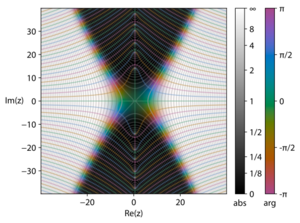Riemann Xi function

In mathematics, the Riemann Xi function is a variant of the Riemann zeta function, and is defined so as to have a particularly simple functional equation. The function is named in honour of Bernhard Riemann.
Definition
Riemann's original lower-case "xi"-function, [math]\displaystyle{ \xi }[/math] was renamed with an upper-case [math]\displaystyle{ ~\Xi~ }[/math] (Greek letter "Xi") by Edmund Landau. Landau's lower-case [math]\displaystyle{ ~\xi~ }[/math] ("xi") is defined as[1]
- [math]\displaystyle{ \xi(s) = \frac{1}{2} s(s-1) \pi^{-s/2} \Gamma\left(\frac{s}{2}\right) \zeta(s) }[/math]
for [math]\displaystyle{ s \in \mathbb{C} }[/math]. Here [math]\displaystyle{ \zeta(s) }[/math] denotes the Riemann zeta function and [math]\displaystyle{ \Gamma(s) }[/math] is the Gamma function.
The functional equation (or reflection formula) for Landau's [math]\displaystyle{ ~\xi~ }[/math] is
- [math]\displaystyle{ \xi(1-s) = \xi(s)~. }[/math]
Riemann's original function, rebaptised upper-case [math]\displaystyle{ ~\Xi~ }[/math] by Landau,[1] satisfies
- [math]\displaystyle{ \Xi(z) = \xi \left(\tfrac{1}{2} + z i \right) }[/math],
and obeys the functional equation
- [math]\displaystyle{ \Xi(-z) = \Xi(z)~. }[/math]
Both functions are entire and purely real for real arguments.
Values
The general form for positive even integers is
- [math]\displaystyle{ \xi(2n) = (-1)^{n+1}\frac{n!}{(2n)!}B_{2n}2^{2n-1}\pi^{n}(2n-1) }[/math]
where Bn denotes the n-th Bernoulli number. For example:
- [math]\displaystyle{ \xi(2) = {\frac{\pi}{6}} }[/math]
Series representations
The [math]\displaystyle{ \xi }[/math] function has the series expansion
- [math]\displaystyle{ \frac{d}{dz} \ln \xi \left(\frac{-z}{1-z}\right) = \sum_{n=0}^\infty \lambda_{n+1} z^n, }[/math]
where
- [math]\displaystyle{ \lambda_n = \frac{1}{(n-1)!} \left. \frac{d^n}{ds^n} \left[s^{n-1} \log \xi(s) \right] \right|_{s=1} = \sum_{\rho} \left[1- \left(1-\frac{1}{\rho}\right)^n\right], }[/math]
where the sum extends over ρ, the non-trivial zeros of the zeta function, in order of [math]\displaystyle{ |\Im(\rho)| }[/math].
This expansion plays a particularly important role in Li's criterion, which states that the Riemann hypothesis is equivalent to having λn > 0 for all positive n.
Hadamard product
A simple infinite product expansion is
- [math]\displaystyle{ \xi(s) = \frac12 \prod_\rho \left(1 - \frac{s}{\rho} \right),\! }[/math]
where ρ ranges over the roots of ξ.
To ensure convergence in the expansion, the product should be taken over "matching pairs" of zeroes, i.e., the factors for a pair of zeroes of the form ρ and 1−ρ should be grouped together.
References
- Weisstein, Eric W.. "Xi-Function". http://mathworld.wolfram.com/Xi-Function.html.
- Keiper, J.B. (1992). "Power series expansions of Riemann's xi function". Mathematics of Computation 58 (198): 765–773. doi:10.1090/S0025-5718-1992-1122072-5. Bibcode: 1992MaCom..58..765K.
 |

